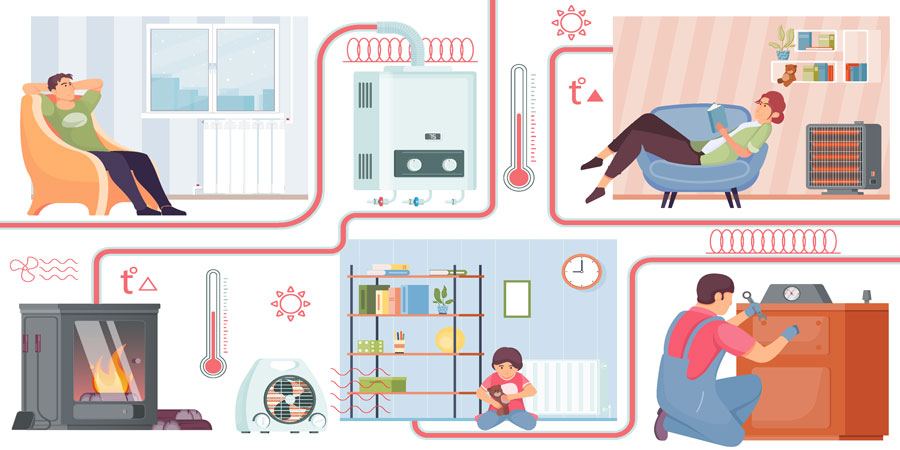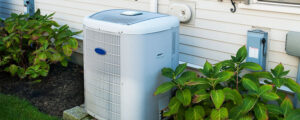Central heating is the most comfortable and practical solution for heating homes, ensuring a constant air temperature in the building. The widespread introduction of advanced resource-saving technologies and weather-dependent control has made heating systems even more reliable and economical, reducing utility bills by almost a third. BHC&Air is a certified HVAC contractor offering expert central heating installation and upgrade services in Colorado – find out what modern heating technology can do!
What Are Central Heating Systems
Central heating is a system for generating, distributing and transferring heat to heat several zones. A heat generator located in a separate room heats several zones at the same time by transferring energy to a fluid circulating in a closed loop.
In most American homes, the heat source is a gas or electric furnace, less commonly a steam boiler or air pump. To distribute heat between rooms, they use pipelines, radiators or ventilation ducts; to reduce energy costs they install equipment for zone temperature control. Thermostats, multi-stage valves and variable speed fans control the heating intensity by increasing or decreasing the heat supply to individual heated zones.
Common Types of Heating Systems
Depending on the way heat is generated and distributed, there are several types of central heating systems; in the United States, forced-air heating systems are the most common. Over 60% of households use a gas furnace as a heat source, with another 28% preferring an electric furnace. The heat from the furnace is blown into the ducts by a fan and convected into the heated rooms; the mutual integration of ventilation and heating systems provides significant benefits:
- fast heating of the room;
- concealed wiring;
- combination of heating and air conditioning;
- possibility of dehumidifying humid air in summer.
The weakness of furnace heating appears to be the difficulty of arranging zone control of heating with a single central thermostat. In addition, gas furnaces are considered a fire hazard, so only a certified contractor with a permit should install and maintain the furnace unit.
Hydronic heating systems use water as a coolant, which circulates through a closed loop that links the hydronic boiler to the heating appliances. Hydronic systems develop higher efficiency than furnaces, but the possibility of installing boilers is limited by the significant amount of investment and lack of available space for boiler room arrangement. Hydronic systems with precision temperature and pressure control are recommended for commercial spaces and large homes that require zone heating.
Ductless heating systems – electric and gas heat pumps, or mini splits are relative newcomers the HVAC market. In winter, the heat pump combines the functions of air conditioning and heating of air masses blown by a compressor, and in summer it works as the air conditioner. Among the advantages of heat pumps are compactness, environmental friendliness and low cost of installation, but the limited power reserve does not allow to consider mini splits as the main source of heat in regions with frosty winters (-4…-7F and below).
Heat can be transferred from the generating unit through conventional radiators, concealed ducts and underfloor heating systems – piping systems embedded in concrete screed or heat-resistant flooring. Underfloor heating is appreciated for a more even distribution of heat without drying out the air; similar floor installations with electric heating have been developed for ceramic and stone floors.
What to Know Before Installing a Central Heater?
Even with small square footage, central heating installation is still a costly and time-consuming endeavor, but with careful planning, installation costs can be reduced by 30-40%. Before embarking on a major renovation, analyze the current state of heating in your home and the savings available by following these five simple tips.
- Weather and climate conditions: the lower the average winter temperature is, the more powerful heating equipment you will need.
- Space for the heat generator and auxiliary equipment: the higher the power, the more impressive the size. Therefore, the equipment should be located in a place with easy access to the main components of the unit and as far away from bedrooms as possible.
- Availability of fuel: it is advisable to heat the house with gas if there are low tariffs for blue fuel and the possibility of free connection to the main networks.
- Free time: installation of a central heating system can take up to several weeks; during this time, it is important not to go anywhere and stay in touch with the installation team.
- Refinancing programs: participation in municipal and state programs to promote green technologies opens access to preferential targeted loans and partial reimbursement of expenses for the purchase and installation of energy-saving equipment from budget funds.
It is possible to calculate the approximate cost of central heating installation to assess your financial possibilities using an online calculator. The exact amount can be announced only after a professional calculation of the heating according to technological standards, which BHC&Air experts will gladly perform for you.
What Will You Need To Install a Central Heating System?
When installing central heating systems, most of the costs are incurred on the purchase of equipment, but in the future all costs will be recouped because of the high performance and prolonged service life of the system. First of all, the purchase of a heat generator should be taken care of, then, depending on the heat source, heating devices, control elements and fittings are selected; for a forced system with stove heating, the list of components looks like this:
- radiators and thermostats of various types;
- multi-stage control valves;
- program control unit with remote control;
- filters, fittings and accessories.
The ductless mini splits are equipped with a compressor unit and an internal air treatment unit, connected by a pipeline. If a complete installation of central heating on the basis of a hydronic boiler is planned, the set of elements of the system looks different; the components must include hot water pipes and fittings, circulation pump, storage tanks and expansion tanks.
What Does Installation of a Central Heating System Involve?
Do not be surprised that the average price of central heating installation with a gas furnace is up to 10000 USD, with an electric furnace – up to 7000 USD; hydronic turnkey systems are even more expensive – up to 15000 USD. Installation of central heating cannot be cheap: it involves complex technical operations, specialists of different profiles and expensive special equipment. It also includes the cost of design and preparatory activities, without which it is impossible to properly install and, consequently, to function the heating systems correctly.
Is It Difficult to Install Central Heating Yourself?
The installation and maintenance of the central heating system is the concern of professional contractors who have obtained the appropriate NATE licenses. Moreover, if the gas equipment is installed by an unlicensed technician, the project will not be approved by the supervisory authorities, which leads to administrative penalties and difficulties in selling the property.
A non-specialist does not know all the subtleties of installation work, so do not even try to mount the system yourself. Mistakes in connection and adjustment of heating equipment can lead to an accident with severe consequences for the family budget. In the end, you will still have to resort to the services of a contractor and reinstall the system with a large overpayment, so it is better to do everything qualitatively right away.
Installing Central Heating: Step-by-Step Guide
Heating systems shall be installed in a strict sequence, ensuring smooth interaction of all links of the executive chain, reducing the time and the possibility of rapid troubleshooting. In total, the complete installation of central heating in a private house involves at least six different operations:
- project development, heating calculation and equipment selection;
- determining the location of the main units;
- arrangement of radiators in heated rooms;
- laying of pipes and connection of control equipment;
- pressure testing and commissioning;
- correction of defects and commissioning of the object.
Hiring Experts For Central Heating System Installation
Delegating installation work does not just save time and avoid unnecessary complications – contracting companies provide guarantees. The right to warranty service is confirmed by a work acceptance agreement signed by the customer and the head of the installation team. Provision of services on design and installation of turnkey heating systems is one of the main advantages of a professional approach: you get a comprehensive solution with optimized cost estimates and excellent quality of service:
- polite and tidy staff;
- reduction of noise load;
- removal and disposal of construction waste according to regulations;
- convenient scheduling and reduced downtime;
- high-tech installation equipment;
- quality preparation and cleaning of the workplace.
The price of central heating installation is significantly reduced if you use the services of local contractors offering more attractive rates and impressive discounts to local residents. The close proximity of warehouses with a wide range of components for heating systems shortens the timeframe of projects. In addition, the local BHC&Air company is better oriented in the realities and offers economically feasible solutions for heating the house taking into account the specifics of the region.
Post-Installation Maintenance and Tips
In order to maintain optimum operating conditions of the climate technology, the heating system should be serviced and flushed twice a year – at the beginning and at the end of the season. For early detection of malfunctions, it also makes sense to carry out a self-inspection of the climate equipment. Every month, check the condition of the linings, filters and insulation, adjust the equipment settings and don’t forget to wipe off dust – this improves heat output.
If you have a hydronic system, keep the boiler pressure at 1-2 bar, and in homes with stove heating, install a carbon monoxide detector. Make sure that the heat is evenly distributed between the heated rooms; if cold islands appear, remove air locks by blowing out. Scheduled maintenance of heating systems in Denver and Colorado is made on the basis of a subscription contract; for details leave a request on the site, and soon you will be contacted by a manager on duty.





